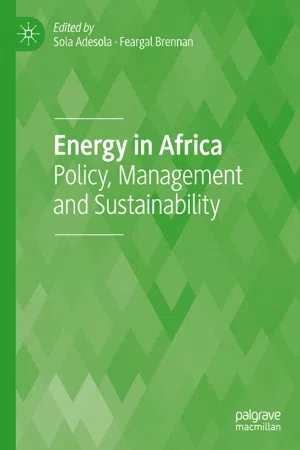Energy is an integral part of a modern economy due to the important role it plays as an important factor of production employed in the production of goods and services, when combined with capital and labour (Keho 2016). It is also a significant contributor to global warming due to greenhouse gas emissions (Kolawole 2017). Africa’s energy sector is vital to its future achievement of socio-economic growth and development . This is in sharp contrast with the abundant energy resources available, which could be harnessed to provide the needed energy. To achieve sustainable economic growth and development in Africa, affordable , sustainable, and reliable energy must be provided. The stakes are enormous. Achieving the economic, social, and environmental promise of the region depends on the ability of the stakeholders to develop the energy infrastructure.
Africa Energy Outlook
The overall energy landscape in Africa is changing. Africa has experienced more rapid economic growth than in the past, with a corresponding increase in the demand for energy. Keeping pace with energy growth and needs is priority for policymakers, to enable economic growth and extend access to modern energy to all. These are not easy challenges, where supply lags demand and over 600 million people in Africa still do not have access to electricity, and approximately 730 million people rely on traditional biomass (IEA 2014). The percentage population with access to electricity in North Africa, West Africa, East Africa, Central Africa, and Southern Africa are respectively 98%, 47%, 23%, 25%, and 43%. Gross domestic product (GDP) per capita is generally three to five times higher in North Africa, where less than 2% of the population is without access to electricity (IEA: World Energy Outlook 2014). In contrast, half of the population in West Africa and three-quarters in East Africa and most of Southern Africa lack access to electricity (although only 15% in South Africa lack electricity access ). North Africa on average consumes eight times more electricity per capita than the rest of the continent, excluding South Africa.
Trade and Investment
Since 2013, the Sub-Saharan economy has more than doubled to reach $2.7 trillion (IEA 2014). Recent economic growth is attributed to a variety of factors, including a period of relative stability and security, improved macroeconomic management, strong domestic demand driven by a growing middle class, global drive for Africa’s resources, population growth, and urbanisation . Nigeria and South Africa are the largest economies so far accounting for more than half of the SSA, with Angola, Ethiopia, Sudan, and Ghana being the next largest. On trade and investment in the region, the role of China’s engagement is notable, particularly in oil, gas, and other natural resources which account for 80% of China’s imports from Africa (Sun 2014) from 2005 to 2011. This is nearly double the level of the European Union and that of the USA over the same period. China’s increasing stake in oil and gas in Africa is well known in Angola, Chad, and Uganda . However, the interest is not restricted to hydrocarbons; Chinese companies are among the largest investors in renewables across the continent including major hydropower projects, solar, wind, and biogas (IEA 2014).
Urbanisation
In defining the Africa energy outlook , rapid demographic trend in Africa is the growing rates of urbanisation, another result of economic growth, and the focus on industrialisation. For instance, the urbanisation rate for Africa was 61% and annual population growth was 1.07% (CIA World Factbook 2011). Population growth has been split relatively evenly between urban and rural areas, in contrast to the strong global trend to urbanisation. Only 37% of the Sub-Saharan population lives in urban areas—one of the lowest shares of any world region—which has important implications for the approach to solving the energy challenges. Growth in urbanisation and changing population framework lead to an increase in the demand for energy access and infrastructure .
Market Environment and Infrastructure
Businesses in Sub-Saharan Africa (SSA) most frequently cite inadequate electricity supply as a major constraint on their effective operation . It is a widespread problem that affects both rich and poor countries in energy resources. Insufficient and inferior power supply has a large impact on the productivity of African businesses (Escribano et al. 2010). The power problem is hinged on poor infrastructure ; many countries face difficulties in financing the needed infrastructure costs . The Programme for Infrastructure Development in Africa (PIDA) identifies a need for $360 billion programme of infrastructure investment through to 2040, spread across energy, transport, information and communication technologies (ICT), and trans-boundary water resources (PIDA is led by the African Union Commission [AUC], the New Partnership for Africa’s Development [NEPAD], and the African Development Bank [AfDB]).
Governance, Affordability, and Sustainability
The role of government in the energy sector of Africa is substantial. Governance is defined by Kaufmann et al. (2008) as the traditions and institutions by which authority in a country is exercised and encompasses such factors as the process by which governments are selected, monitored, and replaced; the capacity of the government to effectively formulate and implement sound policies ; and the respect of citizens and the state for the institutions that govern economic and social interactions among them. Significant to the realisation of economic development in Africa is the establishment of more effective and robust systems of governance. Many governments have failed on corruption , poor regulatory and legal frameworks, weak institutions , or poor transparency and accountability to shield actors from economic shock. These failings are significant factors as hindrances to investment in the continent, and thus pose a key issue for the energy sector if they are to attract foreign investors. Some countries have made progress than others in improving energy sector governance, but this is far from complete. For instance, five out of the nine countries producing 100,000 barrels per day (kb/d) of hydrocarbon liquids have new petroleum law under consideration—these include Nigeria , Ghana, Gabor, Congo, and South Africa. According t...
